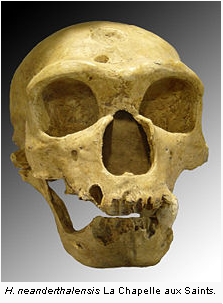

  |
Neandertal man , a subspecies of Homo sapiens, the species to which contemporary humans belong, known as H. sapiens neandertalensis after Neanderthal, Germany, the valley where the first specimen was found. Many scientists classify Neanderthal as its own species (H. neandertalensis), pointing to the large number of anatomical differences between it and H.sapiens, and recently to the number of genetic mutations in mtDNA. Anatomically Neanderthals were somewhat shorter but much more robust than contemporary H. sapiens. Distinctive cranial features of Neanderthals included prominent brow ridges, low, sloping foreheads, a chinless and heavy, forward-jutting jaw, and extremely large front teeth. The shoulders and pelvis were wider, the rib cage more conical in shape, and the forearms and lower legs shorter. When placed in an evolutionary perspective, Neanderthal anatomy gives the impression of a large and somewhat “primitive” hominid, as though the evolutionary trajectory of Homo sapiens had somehow reversed itself. This impression is offset somewhat by the observation that the Neanderthal braincase measured on average about 1600 cc, larger than contemporary Homo sapiens (1350 cc). |
The unique anatomy of Neanderthals probably reflects the fact that they were the first hominid to spend extensive periods of time in extremely cold environments, having evolved in Europe at the onset of the most recent glaciation of that continent (see Pleistocene epoch ). For example, their thick, squat build was adapted to maintaining body temperature under harsh climatic conditions. Large front teeth may have reflected a practice common among Eskimo populations of softening animal skins by chewing. Forceful chewing is also suggested by the heavy jaw and brow ridge, both of which serve to buttress powerful muscles.
Neanderthal phylogeny remains somewhat enigmatic, despite the relative abundance of fossil remains. Among African and Asian archaic Homo sapiens, the reduction in skull and brow ridge thickness and the expansion of the forehead proceeded gradually, with anatomically modern Homo sapiens present by 150,000 years ago in S and E Africa. In contrast, by 125,000 years ago, European archaic Homo sapiens had diverged into the classic Neanderthal form, which persisted in some areas until 28,000 years ago.
Culturally, Neanderthals are closely associated with a stone-tool tradition known as the Mousterian of the middle Paleolithic . They were proficient hunters. As in most cold environments, plant foods were probably relatively scarce and consumed only seasonally. Purported evidence of aesthetic behaviors and of religious beliefs among Neanderthals remains relatively scant and controversial, leading many experts to question the extent of their linguistic capabilities. Controversy also persists regarding the fate of Neanderthals, with opinion divided between those who argue that they became extinct and were replaced by modern H. sapiens and those who argue that their anatomical distinctions were diluted through gene flow (see genetics ) with other H. sapiens. Tests conducted on surviving Neanderthal DNA have shown little similarity to the DNA of modern humans.
Mis en ligne le 10/09/2004 par Pierre Ratcliffe. Contact: (pratclif@free.fr) site web: http://pratclif.com